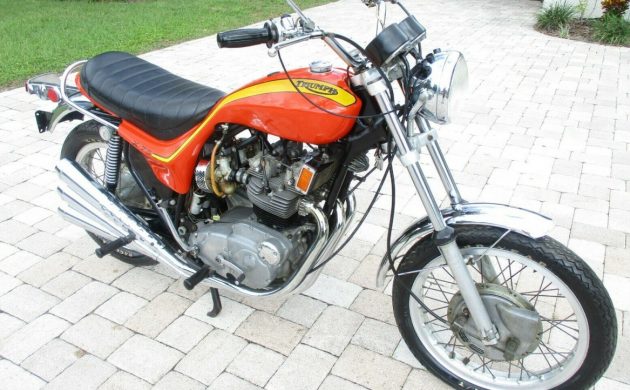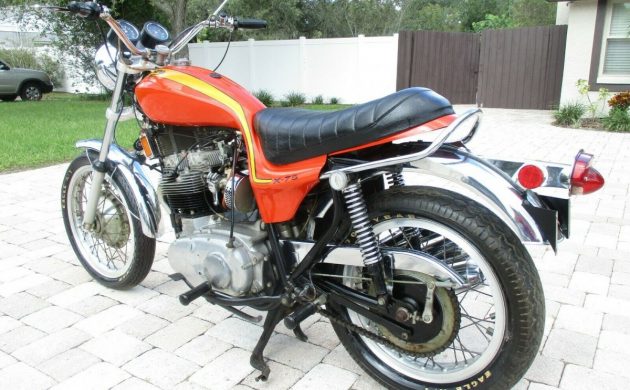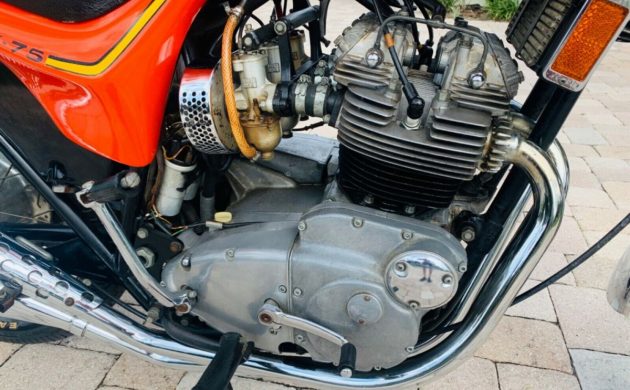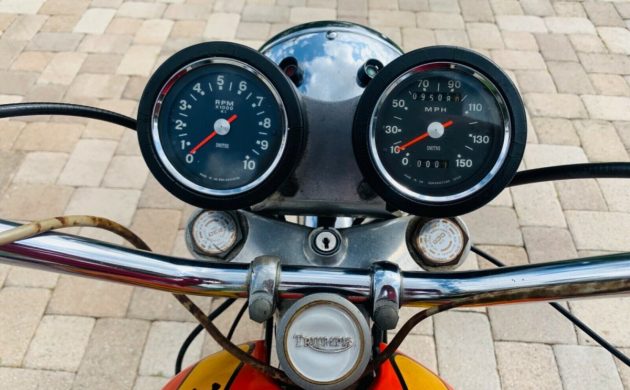This 1973 Triumph Hurricane X75 was discovered as part of a collection of vintage motorcycles, and is a rare find today in such nicely preserved condition. Though not a huge seller when new, the Hurricane is claimed by many to have ushered in a new era of motorcycle design, considered the first-ever factory custom. Just 1,172 Hurricanes were made, so finding one that isn’t a basketcase explains the current bidding here on eBay rising to over $14,000.
This Triumph is listed by the same seller whose numbers-matching BMW R25/2 was recently featured. The Hurricane is noted for several design achievements, but some of the more notable ones include Borrani aluminum wheels, polished fenders, and a wild three-into-three exhaust. The seat and tank unit were also considered innovative – just look at how it drops below the seat, set off by a single stripe.
The bike itself wouldn’t be considered quick, but the design was intended to give off the image of being more powerful than it was. Design experts at the time felt it captured perfectly what an American’s vision for a perfect Triumph bike would be. Even the original designer, Craig Vetter, acknowledged that the bike’s primary function was to be noticed by women. Today, it’s also noticed by collectors.
Given the iconic design and limited production numbers, it’s not surprising to see the active bidding. The seller notes the engine and frame are still numbers matching, and that the bike will turn over when rocked into gear. He has not attempted to start it, so it’s being sold as a non-running project. A clean Florida title is included. Whether running or standing still, this is a gorgeous motorcycle – and still an icon.






This is a classic case of when you have a brilliant designer, you keep him designing and improving; you do NOT promote him to management. In 1937 Triumph introduced the Speed Twin which was revolutionary, to say the least. Nothing handled or performed like it. Triumph could barely keep up with the demand. But what did Triumph do? It promoted that designer to management. His brainchild went right to his head and he was convinced that it was as good as it could get and nothing could be improved on it. Burt Hopwood, designer of the Norton Dominator Twin, foresaw the Japanese invasion and warned the powers at be that it was going to happen. When he came to Triumph he tried to reason with management who promptly dismissed his attitude with the proclamation: “They just make little bikes and when the riders of the Honda 50 are ready for something larger they’ll buy ours.” Hopwood said: “By that time the Japanese will be building the larger bikes.” On his own, he designed a 250 single, 500 twin, 750 triple and 1000 four, all using the same piston, rod, valves, and I think cylinders and heads. Hopefully the common parts would keep the costs down while filling all the stop gaps as riders skills and desires increased. But his efforts were promptly dismissed. His warnings came true when the Japanese started building bigger, smoother and somewhat more reliable bikes. The Trident and Rocket 3 of 1969 were loosely based on Hopwood’s design if my sources are correct. But they were too little too late. It took many years for Triumph to get out of the glue. This is a nice bike and a reasonable performer. Way beyond my pay grade but someone is going to be happy with it. I hope the buyer rides it and has many great miles ahead of him…
I’ll be surprised if this bike gets ridden much–it’s too much of an investment, and if it goes down, that bodywork is irreplaceable! A standard Trident would handle and stop better for a lot less money, too.
That’s exactly what happened. British manufacturers once regarded competition from the far-east with little concern but, by the late 1960s, Japanese motorcycles had become serious machines enjoying commercial success. Both Kawasaki’s 500cc H1 triple and Honda’s 750 Four debuted in 1969, the former fast but lethally unstable, the latter more refined. Three years on, the release of Kawasaki’s z900 confirmed the maturity of the Japanese product.
The Japanese had designed from a clean sheet of paper and buyers found, unlike British bikes, electrics were reliable and mechanicals not subject to the oil-leaks which the British had for decades claimed were endemic to the breed; far-eastern engineering was now mass-producing bikes a generation advanced.
However, the British industry was chronically under-capitalised so, lacking resources to develop new models, tried to improve existing designs.
The big Nortons, named Commando since 1967, had long been a benchmark for high-performance motorcycles and although the Kawasaki H1 had matched its speed, other characteristics meant it could really be enjoyed only in a straight line and even then, was best handled by cautious experts. The Honda 750 and Kawasaki 900 were both better and warning of what was to come.
Norton’s response in 1972 was the hastily created Commando Combat, the engine tweaked with a high compression ratio, bigger carburettors, larger ports and a wild, high-lift, long-duration camshaft. These modifications, quite usual for racing engines, are not suitable for the road and the “peaky” Combat’s only advantage was great top-end power. Unfortunately, the gains high-up in the rev-range compromised the low and mid-range performance, the range at which a road-bike most often operates. Indeed, at low revs, the torque-curve actually went the wrong way. Sadly, it wasn’t possible for anyone long to enjoy the pleasures of all that power because the Combat specification exposed weaknesses in pistons, bearings and crankshafts. Main bearing life could be as little as 4000 miles (7000 km) but plenty of engines succumbed to other failures long before.
As a consolation, even if the Combat wouldn’t keep going, it was easy to stop, the new disk brakes were excellent.
Geomechs, ACB, you both summarized the British bike industry clearly and concisely. A “recent” example of that was best demonstrated after John Bloor looked to start Triumph production, having bought the rights when he bought the factory for the land it was on. When an engineer remarked that the cylinder boring machine made an off-set bore the previous shop foreman was brought in to explain the puzzle. Without saying a word the foreman looked around the room, picked up a 4×4 post from the corner, walked over to the boring in process and propped the post against the operating bore machine then leaned on it, producing a straight bored set of cylinders…
This bike has always drawn lookers; beautiful flowing lines tied together into one windswept design. This was an early of Craig Vetter’s gorgeous designed specials-unfortunate that this was only a 3 gallon tank!
Other folks’ comments about the last days of the British bike industry sum it up well. I’d just add a couple of things: the Triumph Trident and BSA Rocket 3 had basically the same engine, except that the BSA’s cylinders were canted forward while the Triumph’s were vertical, and their timing covers were shaped to look more like the twins in each brand’s line. The Hurricane basically had the BSA engine with a Triumph timing cover. Also, even though it was a ’73 model, it had ’71-72 brakes, fenders and lights, because that’s what Vetter designed it around, and they were afraid using the (improved) ’73 gear would hurt the bike’s appearance. It was a sad irony that the Hurricane was originally going to be a BSA (storm-related names were a BSA trademark) but there was no BSA left when the bike hit the market. Lastly, I think the article misrepresents the bike’s performance. A Trident would stay with a CB750 or Commando; the Kawasaki Z1 was the only bike of the time that could really outrun it. On the other hand, the extended fork on the Hurricane didn’t help the usually great handling of the Trident.
A stock Triumph Trident, BSA Rocket 3, or Norton 750 Commando could keep up with. a Z-1 to about 120 mph.
I might be known as a Harley guy, but I have a strong appreciation for anything with wheels. American, foreign, whatever. I like it all. So I will admit that this is down right cool!
Unfortunately, I don’t know enough about these to own one. Besides that, it would look like an elephant attacking a football if I got on it to ride lol. So I think I gotta pass. Well, I gotta pass for so many other reasons beyond what I just wrote, money being the absolute biggest reason lol.
I’d say you’re not a Harley guy, Stevieg, but a rider who prefers Harley’s-it’s apparent you’re one of us that rides a bike, not just a brand.
The Triumph Hurricane is one I wanted badly but never owned. However, looking back I’d say it was just as well since this bike had a similar issue to that of the HD VRod-you don’t ride any distance that doesn’t have a gas station very close by! Maybe it’s because the engineers never traveled a road that had signs posted proclaiming “Next fuel available 112 miles”, or their engineered purpose was just to cruise the urban streets..
Where did this come from? During my afternoon nap, I see. A Triumph Hurricane, doesn’t that take the biscuit. Always loved a “Limey”, never had the guts to own one. My buddy had a TT500 when I had my Suzuki TS 400, and it did everything the TS did, which isn’t saying a lot, but a fun bike. I beg to differ with the author, I thought the British 3 cylinders were fully capable of straightening your arms out, I thought their crowning achievement. The goofy exhaust turned many off, me included, but I feel these and Rocket 3’s were the nicest British bikes made. $14g’s for one? More foolishness and left brake/right shift will confuse many.
I always had thought that 3 side by side air-cooled cylinders usually overheated in the center cylinder because of no wrap around the side air flow ??? I believe this was a common problem with early 3 cylinder air cooled engines.
I’d heard that too, and some of the guys said they averted that by running a colder plug in the middle cylinder. Later on, Lockhart came out with a thermostatically controlled oil radiator that we KZ900/1000 guys used for the same reason! Sometimes engineers overlook the stuff that becomes an obvious issue and the mechanics have to work around their designs..
I heard stories about the old inline 4s like the Henderson, Indian/Ace and others. They talked about that #4 piston moving like a cold blue shadow within a cherry pink cylinder wall. That’s hot. They obviously cooled OK because they built lots of them…
I have a Hurricane. Lovely to look at, horrible to ride, the same can be said of my export Rocket 3 too. The British bike industry was a mess long before it actually died no doubt about that. Doug Hale had the triple up and running in ’64 and it could have and should have been in production in ’65. The original P1 looked like a Bonnie with a triple Triumph motor. But BSA & Triumph stuck to building twins and when demand came for more power the Japs beat them to it. We should of had the Triumph T150/BSA Rocket 3 in ’65 and the Triumph T160 in 1968 then things may well have turned out different.
I have a Rob North Triple flatracker which I have had built to the following specification and it is exactly what BSA/Triumph should have offered Joe Public.
It is light and handles like an absolute dream. It has a disc brake on the back and two up front. It has a P&M belt drive, dry clutch (Google P&M) and Keihin CR carbs. The engine is completely standard but because it’s light it goes like stink. The grin factor is 100% everytime I take her out.